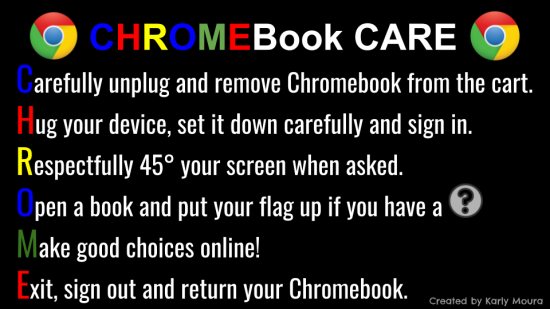3 Ideas for Making Technology Manageable in Your Classroom
- October 4, 2023
- By Karly Moura

The joy of integrating technology meaningfully into our classrooms can oftentimes be overshadowed by the all of the management concerns that go along with it. Device logistics, login cards, a flood of the latest and greatest apps can all trigger a sense of panic as we envision our education technology goals.
Whether you are a 1:1 or a 1 device classroom you still need a plan for making technology integration manageable. A few simple strategies and routines will help you and your students get the most out of the technology you have.
1. Find a buddy class to share the responsibility of teaching.
Having older students come in and help teach your class how to log in to the devices or how to use a new app benefits everyone. Younger students will have one-on-one attention while they learn and the older students will benefit from using their communication skills to explain the process to their peers. As a teacher of older grades you could have a “Tech Squad” in your own classroom made up of students who show responsibility, technical knowledge and a knack for teaching others. Students can also create video tutorials for other students, and teachers, to access when a buddy class is unavailable.
2. Have protocols for technology management right from the start.
Just as we do when we begin the year teaching our students what our bathroom and homework policies are we also need to let students know what to expect when using technology in the classroom. Make a list of common issues that pop up when utilizing technology in your classroom and make a plan for each. What will students do if they have a question? How do you get your class’s attention when they are working on their device? What is the protocol for taking out and putting back your classroom devices? Having a clear plan for your students to follow will help make you all feel more comfortable if and when problems do arise.
 At my school we almost exclusively use Chromebooks so we created a list of protocols we all follow when students use their devices. Using the word CHROME to remember the procedures, all students at every grade level hear the same presentation and have the same expectations as they move through grade levels and between classes. This keeps everyone on the same page and management is kept simple.
At my school we almost exclusively use Chromebooks so we created a list of protocols we all follow when students use their devices. Using the word CHROME to remember the procedures, all students at every grade level hear the same presentation and have the same expectations as they move through grade levels and between classes. This keeps everyone on the same page and management is kept simple.
3. Avoid overwhelming yourself or your students with too many new apps and tools.
 Instead choose three versatile apps or tools to learn with your students that they can use throughout the year. The advice I was given years ago by a colleague still serves me well. He recommended choosing three tools or apps that you and your students can use for many different projects and in many different subject areas.
Instead choose three versatile apps or tools to learn with your students that they can use throughout the year. The advice I was given years ago by a colleague still serves me well. He recommended choosing three tools or apps that you and your students can use for many different projects and in many different subject areas.
When asked for recommendations I suggest the following:
- Choose one digital portfolio and family communication app such as SeeSaw. Even within a one device classroom students can upload their work to a digital portfolio to share with their families and give them a window into their academic lives.
- Decide on one creation app or tool that students can use in many different ways. There are many creation apps out there, be sure to choose the one that works best for you and your students.
- Find a collaboration app or tool where students can share with one another, with other classes in the school, county or even across the world. Sharing outside of the four walls of you classrooms gives your students an authentic audience. Knowing that their work will be seen by more people than just their teacher is motivating and rewarding for students.
Meaningful technology integration can allow us to teach in ways we never thought possible. Having a plan for how technology use will look in your classroom can make a big difference as you design your lessons.